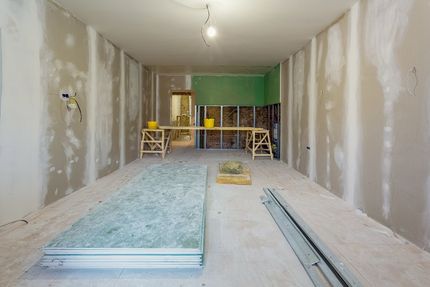Drywall Setup Made Easy: Tips for Perfect Results
Drywall setup is frequently viewed as an overwhelming task, yet with the best strategy and expertise, it can end up being a workable venture. Mastering strategies for reducing, hanging, and completing drywall can considerably influence the result.
Selecting the Right Materials
Selecting the suitable materials for drywall installation is crucial to achieving a sturdy and aesthetically pleasing finish. drywall repair. The primary part, drywall sheets, usually been available in various densities, with 1/2-inch sheets being common for interior wall surfaces. For locations calling for added wetness resistance, such as kitchen areas or restrooms, take into consideration using green board or concrete board, which are specially designed to endure humidity

Preparing the Installment Area
Before starting the drywall installation procedure, it is necessary to prepare the installation area completely. This prep work entails numerous crucial steps to ensure a smooth and effective task. Clear the area of any furnishings, home appliances, or obstructions that can impede access. A tidy work space lessens the threat of damages to existing products and permits effective movement during installation.
Next, check the wall surfaces and ceiling for any kind of blemishes, such as splits, openings, or mold. Address these problems beforehand; patch any damages and permit adequate time for fixings to dry. Furthermore, ensure that electric outlets, switches, and pipes are properly positioned and represented, as this will influence drywall positioning.
Think about the environmental problems. A secure temperature level and humidity degree are essential for ideal adhesion and performance of the drywall materials. Use a dehumidifier or heating system to create ideal conditions. if needed.
Trimming and Hanging Drywall
The trick to efficient drywall installation exists in the accurate cutting and hanging of the panels. Begin by determining the room properly, taking into account any type of obstructions such as electric outlets or home windows. Use a straight edge and an utility blade to score the drywall along your measurements, after that break it along the scored line for a tidy break. For even more complex cuts, such as around electrical outlets, a drywall saw can be used for accuracy.

Always function from the top down and left to right, ensuring that you keep a staggered pattern to improve stability. Properly hanging the drywall sets the foundation for a smooth finish, inevitably resulting in premium lead to your drywall project.
Taping and Mudding Strategies
While correct cutting and hanging of drywall establishes the phase, the following critical action entails mastering taping and mudding methods to make sure a smooth coating. Taping is necessary for strengthening joints and protecting against splits; it includes embedding tape into the used joint compound (mud) Beginning with a high quality fiberglass or paper tape, applying the tape over the joint and pushing it into the wet mud making use of a taping knife, making sure no air bubbles continue to be.
Once the tape is in area, apply a thin layer of joint substance over the tape, feathering the sides to develop a smooth transition to the drywall surface. Allow this layer to completely dry entirely prior to sanding it gently to remove blemishes. Repeat this process, applying added coats of mud as required-- generally a couple of coats-- while gradually widening the application location with each layer to achieve a seamless appearance.
After the final layer dries out, sand the surface area with a fine-grit sandpaper until smooth. drywall repair. Remember to wear a mask during sanding to prevent breathing in dust particles. Understanding these taping and mudding methods is critical for achieving a professional-quality surface in your drywall setup
Ending Up Touches for Perfection
Attaining a perfect drywall installation surpasses mudding and taping; it finishes in the ending up touches that raise the general look. These final actions are vital in ensuring a professional-grade surface that enhances the aesthetic appeals of your room.
Begin by sanding the dried out joint compound to create a smooth surface area. drywall installation. After fining sand, wipe down the wall surfaces with a moist towel to get rid of any kind of dust particles, guaranteeing a tidy surface for painting.
Next, use a guide particularly designed for drywall. This action is vital, as it helps secure the joint compound and gives an uniform base for the overcoat. As soon as the primer dries, inspect for any kind of blemishes, and touch up as needed.
Conclusion
To conclude, effective drywall setup pivots on the careful choice of products, thorough preparation of Home Page the installment area, and exact execution of cutting and hanging strategies. Proficiency of taping and mudding procedures is necessary for attaining a smooth surface. Furthermore, interest to finishing touches, including priming and touch-ups, guarantees a professional-grade outcome. By adhering to these guidelines, the quality of workmanship can be dramatically improved, adding to the overall visual and capability of the area.
Drywall installation is usually viewed as a daunting task, yet with the ideal strategy and expertise, it can become a convenient venture.Selecting the ideal products for drywall installation is critical to achieving a sturdy and visually pleasing surface.Before starting the drywall installation procedure, it is important to prepare the installment area extensively. Mastering these taping and mudding techniques is vital for attaining a professional-quality surface in your drywall setup.
In final you can look here thought, effective drywall installation pivots on the careful selection of materials, complete prep work of the installation area, and precise implementation of reducing and hanging methods.
Comments on “Comprehensive Drywall Contractor Support for New Builds”